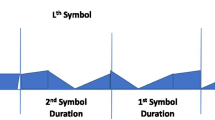Abstract
In this paper, we present a generalized accurate methodology to predict the bit error rate performance for non-coherent chaos-based communication systems. The Gaussian approximation approach, which is widely used to compute the performance of such systems, leads to inaccurate results, especially with respect to low spreading factors. Our new approach based on the chaos bit energy distribution gives accurate results even for low spreading factors. The system is studied and simulated under an additive white Gaussian noise, Rice and Rayleigh channels. Finally, we compare our approach to the Gaussian approximation approach. Computer simulations shows a high accuracy for our method, especially for small spreading factors.
Similar content being viewed by others
References
Geisel T., Alouini M. S. (1984) Statistical properties of chaos in Chebyshev map. Physics Letters A 6: 263–266
Isabelle S. H., Wornell G. W. (1997) Statistical analysis and spectral estimation techniques for one-dimensional chaotic signals. IEEE Transactions on Signal Processing 45: 1495–1497
Kaddoum, G., Chargé, P., Roviras, D., & Fournier-Prunaret, D. (2007). Comparison of chaotic sequences in a chaos based DS-CDMA system. In Proceedings International symposium on nonlinear theory and its applications. Vancouver: Canada.
Kaddoum, G., Chargé, P., Roviras, D., & Fournier-Prunaret, D. (2009). A methodology for bit error rate prediction in chaos-based communication systems. Springer, Birkhäuser, Circuits, Systems and Signal Processing. doi:10.1007/s00034-009-9124-5.
Kaddoum, G., Coulon, M., Roviras, D., & Chargé, P. (2009). Performance of multi-user asynchronous chaos-based communication systems through m-distributed fading channel. In Proceedings EUSIPCO. Glasgow: Scotland.
Kaddoum, G., Roviras, D., Chargé, P., & Fournier-Prunaret, D. (2007). Analytical calculation of BER in communication systems using a piecewise linear chaotic map. In Proceedings European Conference on Circuit Theory and Design. Seville: Spain.
Kennedy M. P., Kolumbán G., Kis G., Jákó Z. (2000) Performance evaluation of FM-DCSK modulation in multipath environments. IEEE Transactions Circuits and Systems 47: 1702–1711
Kennedy M. P., Rovatti R., Setti G. (2000) Chaotic electronics in telecommunications. CRC press, London
Kolumbán G., Kis G., Jákó Z., Kennedy M. P. (1998) FM-DCSK: A robust modulation scheme for chaotic communications. Transactions Fundamentals of Electronics Communications and Computer Sciences 89: 1798–1802
Kolumbán, G., Vizvari, G. K., Schwarz, W., & Abel, A. (1996). Differential chaos shift keying: A robust coding for chaos communication. In Proceedings International Workshop on Nonlinear Dynamics of Electronic Systems (pp. 92–97). Seville: Spain.
Lau F. C. M., Tse C. K. (2003) Chaos-based digital communication systems. Springer-Verlag, Germany
Lau F. M., Cheong K. Y., Tse C. K. (2003) Permutation-based DCSK and multiple-access dcsk systems. IEEE Transactions Circuits and Systems 50: 733–742
Lawrance A. J., Ohama G. (2003) Exact calculation of bit error rates in communication systems with chaotic modulation. IEEE Transactions Circuits and Systems 50: 1391–1400
Mandal S., Banerjee S. (2004) Analysis and CMOS implementation of a chaos-based communication system. IEEE Transactions Circuits and Systems 51: 1708–1722
Pecora L. M., Carroll T. L. (1990) Synchronization in chaotic systems. Physical Review A 64: 821–823
Sushchik M., Tsimring L. S., Volkovskii A. R. (2000) Performance analysis of correlation-based communication schemes utilizing chaos. IEEE Transactions Circuits and Systems 47: 1684–1691
Xia Y., Tse C. K., Lau F. C. M. (2004) Performance of differential chaos-shift-keying digital communication systems over a multipath fading channel with delay spread. IEEE Transactions Circuits System II, Express Briefs 51: 680–684
Xia Y., Tse C. K., Lau F. C. M., Kolumbán G. (2005) Performance of frequency-modulated differential chaos-shift-keying communication system over multipath fading channels with delay spread. International Journal of Bifurcation and Chaos 15: 4027–4033
Yao J., Lawrance A. J. (2006) Performance analysis and optimization of multi-user differential chaos-shift keying communication systems. IEEE Transactions Circuits and Systems 53: 2075–2091
Zhou Z., Wang J., Ye Y. (2008) Performance of multiple-access communication over multipath channel with delay spread. Brikhaüser Transactions Circuits System and Signature Process 2008: 507–518
Zhou, Z., Wang, J., & Ye, Y. (2009). Exact ber analysis of differential chaos shift keying communication system in fading channel. Springer Trans. Wireless Personal Communications 2009. doi:10.1007/s11-277-009-9685-4.
Author information
Authors and Affiliations
Corresponding author
Rights and permissions
About this article
Cite this article
Kaddoum, G., Gagnon, F., Chargé, P. et al. A Generalized BER Prediction Method for Differential Chaos Shift Keying System Through Different Communication Channels. Wireless Pers Commun 64, 425–437 (2012). https://doi.org/10.1007/s11277-010-0207-1
Published:
Issue Date:
DOI: https://doi.org/10.1007/s11277-010-0207-1




